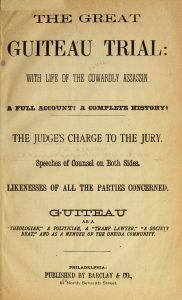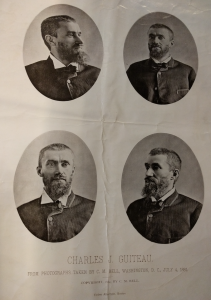
Title page from The Great Guiteau Trial: with life of the cowardly assassin. Philadelphia, Published by Barclay & Co., 1882.
On November 28th, 1881, Charles Julius Guiteau, assassin of President James A. Garfield, took the stand on his own behalf, testifying in court until December 3rd, 1881. Guiteau’s rambling testimony documented his life and his belief that killing Garfield was necessary and divine providence. Following Guiteau’s testimony, the prosecution brought a succession of medical experts, who testified over the course of three weeks that Guiteau was not insane but “depraved,” “sane, though eccentric,” and many other descriptions skirting the definition of legal insanity.1 Guiteau’s mental state was a matter of considerable debate among medical and legal experts, as evidenced by a number of articles, pamphlets and books that are freely available through the Medical Heritage Library.
George Scoville, Guiteau’s brother-in-law, tried to prove that Guiteau was insane through his own set of medical experts, including Dr. George Miller Beard, a specialist in mental and nervous disorders.
Beard championed the rights of the insane and was instrumental in the formation of the “National Association for the Protection of the Insane and Prevention of Insanity.” He worked to reform the law so that the insane could not be found guilty of crime, and became famous (or infamous) for vigorously defending this opinion in the case of Guiteau. Guiteau’s trial inspired Beard in a number of ways, extending to a psychological analysis of the Salem witchcraft “excitement” of 1692 and its application to Guiteau’s trial in this book published in 1882.
Beard is better known today for his promotion of the concept of neurasthenia, or nervous exhaustion, a medical condition primarily afflicting American men in the nineteenth century, characterized

Published photographs of Guiteau by C.M. Bell, taken 2 days after Guiteau shot President Garfield. From the George Miller Beard papers, Box 3, MS 584, Manuscripts and Archives, Yale University.
by depression, fatigue, impotence, mental collapse, and other symptoms. One of Beard’s best-known books on the topic was published the same year as the Guiteau trial: American nervousness: its causes and consequences, a supplement to Nervous exhaustion (neurasthenia).
Beard’s papers reside at Manuscripts and Archives at Yale University, as he was a Yale undergraduate, class of 1862. Beard, and a number of other medical experts called in by Scoville, were unsuccessful in convincing thejury that Guiteau was insane, and despite a plea for leniency, Guiteau was found guilty on January 25th, 1882. He was hanged at the District of Columbia jail on June 30th, 1882.
~This post is courtesy of Melissa Grafe, John R. Bumstead Librarian for Medical History, Head of the Medical Historical Library.
Footnotes
- For a thorough legal examination of the Guiteau trial, see Douglas Linder’s site: http://law2.umkc.edu/faculty/projects/ftrials/guiteau/guiteauhomelite.html






Pingback: Nursing Clio Sunday Morning Medicine
Pingback: Whewell’s Gazette: Year 3, Vol. #16 | Whewell's Ghost